Fact Sheet FS1255
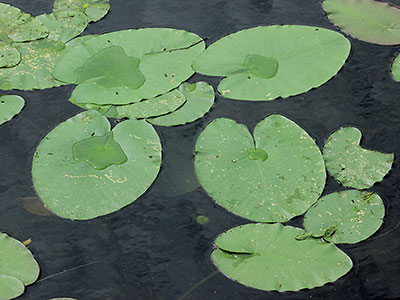
Figure 1. Floating leaf form of spatterdock (Nuphar variegata).
Spatterdock, a member of the water lily family Nymphaeaceae, is a native perennial aquatic plant that commonly occurs in lakes, ponds, slow moving streams, canals, ditches, and tidal reaches of fresh water streams. Alternate names for spatterdock include: yellow pond lily, yellow cow lily, bullhead lily, brandy bottle, and variegated yellow pond lily.
Spatterdock is native to the United States, where it occurs in all states except Hawaii. It is also native to Europe, the West Indies, temperate Asia, and Africa. In New Jersey, spatterdock is found throughout the state. Spatterdock can be a valuable plant for fish and wildlife habitat providing food, shelter, and a place of breeding for many. Leaves provide shade, shelter, and cover from predators for many invertebrates that fish use for food. Seeds are eaten by water fowl and other birds. Muskrat, beaver, and porcupine will eat the rhizomes and deer have been known to graze on leaves and flowers. Many invertebrates spend their entire life cycle on spatterdock with varying effects on the plant. These insects can form gall-like structures and puncture or consume leaf blades, stems, and roots. The water lily beetle, Galerucella nymphaeaea, is a known herbivore of spatterdock (Kouki, 1991; Wallace and O'Hop, 1985).
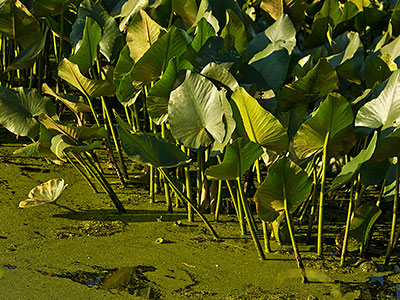
Figure 2. Emergent leaf form of spatterdock (Nuphar advena).
Humans have put spatterdock to many uses. Historical cultures have cooked the rhizome or dried and ground it into flour for baking. It has also been ground for use medically as a poultice. Leaves and roots contain tannin that was used for dying and tanning (WSDE, 2014). More recently this decorative plant is used in aquariums and water gardens. Problems with spatterdock arise due to its growth potential which enables it to reach very large populations in shallow waterbodies possibly displacing or eliminating other plant species (PIMS 2011).
Description
Spatterdock is characterized by its large leaves which are often floating, however submersed and emerged leaves are common (Figs. 1 and 2). This low- to mid-height fleshy herbaceous plant spreads 1–2 m (3.3–6.5 ft) on the water surface and some species emerge 15–60 cm (0.5–2 ft) above the water surface. Long, stout stems arise from large, spongy rhizomes up to 15 cm (6 in) thick with adventitious roots present on the sides and undersides (Fig. 3) that anchor into the muddy bottom, but can also be found growing on floating rhizomes at the surface. Spatterdock rhizomes have the ability to withstand some period of exposure to air. The dark- to light-green leaves exposed to the air (floating or extending above the surface) are thick, leathery, somewhat heart-shaped, 7–40 cm (3–15 in) long with rounded lobes and a distinct midrib. The basal lobe is separated by a triangular sinus (notch) less than half the length of the midrib and attached to a rounded stem (petiole). Submerged leaves are thin, translucent, and attached by short petioles to the rhizomes.
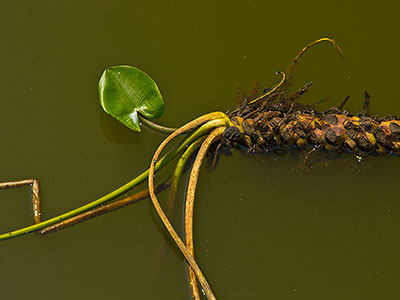
Figure 3. Spatterdock rhizome showing adventitious roots and emerging leaf stems.
Solitary yellow, globular flowers emerge on separate stalks and can float on the water but often rise above it (Fig. 4). Spatterdock flowers commonly possess 5 yellow-green concave sepals, but numbers can range from 6 to 12, occurring in alternating whorls. Hidden by the sepals are small scale-like yellow-golden often red-tinged petals and numerous stamens and stigmas. Flowers bloom from May to October, partially opening in the morning and closing at night. Spent flowers give way to seed heads that burst when ripened spreading ovoid seeds (3&nd6.5 mm in length) over the water surface. Flower and leaf stems die back to the rhizomes in the fall (USDA, 2015; Padgett, 2007; Wiersema and Hellquist 1994 & 1997).
Spatterdock has a broad ecological range with respect to the pH of water and tolerates well-buffered, poorly buffered, and even acidic water bodies (Smits, et. al. 1988). While spatterdock is tolerant of shade and deeper water, it grows best with sun to part-shade in soft sediment at depths of 0.3–1 m (1–3.3 ft). It flowers more readily with full sun. Overwintering as rhizomes and seeds, new leaves emerge below the surface from the rhizomes in early spring and later float on or extend above the surface. Shading by spatterdock leaves helps to suppress the growth of other aquatic plants giving it a competitive advantage. Flowers often bloom all summer long and emit a strong fragrant odor that attracts pollinating insects. Plants can also grow from fragments of the rhizome if broken up. Nuphar species can spread from accidental or intentional introduction and are often implicated as aquatic weed problems where the aggressive vegetative spread can contribute to clogged waterways (Fig. 5; Steward, 1990).
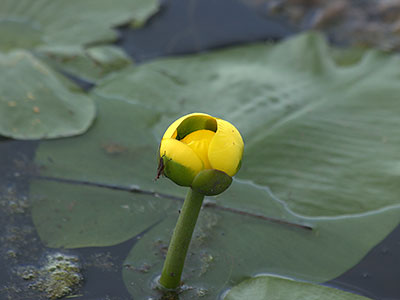
Figure 4. Typical spatterdock flower.
Once treated as a single species (Nuphar lutea) in North America, it is now divided into multiple species unique from the Eurasian N. lutea (Beal, 1956; Crow and Hellquist, 2000). Five species of spatterdock, Nuphar advena, N. pumila, N. rubrodisca, N. varigata, and N. microphylla have been noted in the waters of New Jersey (USDA, 2015).
Prevention and Control Options
Although spatterdock is not considered invasive, its extensive rhizome system allows it to grow and reproduce rapidly if not managed. Rapid growth occurs in shallow water bodies when there is an excess of nutrients allowing the plants to completely cover the surface in just a few years and control becomes necessary. Dense growth of spatterdock in shallow water areas can interfere with boating and other forms of recreation, and causes light reduction and oxygen depletion that can kill fish or other plants.
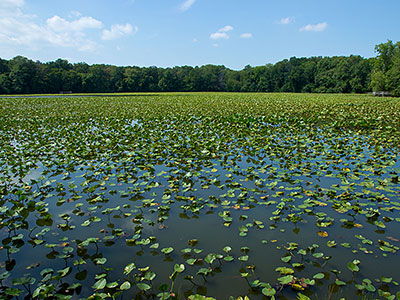
Figure 5. Spatterdock at nuisance level in a 10 acre lake.
Protecting water quality can help control overabundant aquatic plants and is best accomplished by limiting, reducing, or redirecting the input of external nutrients (primarily nitrogen and phosphorous) from waterways. Potential nutrient sources include runoff from numerous sources including lawns and golf courses, agricultural fields, waste from livestock, pets and wildlife, and poorly functioning septic systems. Reductions can be achieved by planting low-maintenance lawns, applying less fertilizer near waterways, using phosphorous-free fertilizer, maintaining vegetated riparian buffers to absorb nutrients, increasing bank stability to reduce soil erosion, and maintaining proper aeration and good water flow. Not addressing the nutrient issues will lead to a perpetual need to control plant growth.
Mechanical Control
Short-term control can be achieved by cutting surface leaves by harvester or hand-held tools. Although the leaves will initially be smaller, the same number of spatterdock plants will generally regrow from rhizomes soon after harvesting during mid-summer, thus only providing temporary control. Plants can be removed by digging rhizomes from the sediment. This is very labor-intensive but provides longer control; however, spatterdock can reestablish from seeds or any remaining rhizomes. A bottom barrier or bottom screen that blocks sunlight (preventing photosynthesis) can be secured to the bottom sediment surface to cover areas of nuisance aquatic vegetation. This technique is applicable only to localized control of relatively small areas.
Biological Control
There are currently no commercially available biological control techniques for spatterdock. Grass carp (Amur spp.), a common biological control species for aquatic plants, will not forage on spatterdock unless virtually no other food is available. While not commercially available, the larvae and adults of the native water lily beetle, Galerucella nymphaeae, feed on the leaves of spatterdock causing the leaves to turn brown and die. In certain years there may be a population explosion of the beetles that can cause 80% or more of a local spatterdock population to become defoliated during the summer.
Chemical Control
The aquatic herbicide glyphosate (product must be specifically labeled for aquatic use) is effective for spatterdock and other floating-leaved plant control. The material is sprayed on surface leaves were it is absorbed into the plant tissue and provides systemic control of the nuisance vegetation. A surfactant rated for aquatic application must be mixed into the treatment solution; see the product label for this information. Since glyphosate is sprayed directly onto the plant, the applicator has control over the treatment area, as opposed to aquatic herbicides applied to the water column for absorption which may spread to affect non-target species. Glyphosate treatments are most effective when applied in the mid- to late summer when the plants are storing energy in the rhizomes for the next growing season. These treatments cause the roots that anchor the rhizomes to decompose and often they will float to the surface. (Welker and Riemer, 1983).
Other active ingredients that have been successful in treating spatterdock with excellent results include 2,4-D and imazamox; and with good results triclopyr, fluridone (Sonar), and imazapyr (Langland, et.al., 2006). A more detailed review of aquatic pesticide use can be found in Rutgers Cooperative Extension fact sheet FS386, ""Aquatic Weed Control" (Hart, 2001). A danger with any chemical treatment is the chance of oxygen depletion caused by the decomposition of dead plant material. If the pond is heavily infested it should be treated in sections allowing a time period of several weeks for decomposition between treatments.
When using chemical control methods, remember these guidelines for aquatic treatment:
- In New Jersey, aquatic pesticide applications (includes ditches) require a permit and state certified applicator.
- New Jersey Department of Environmental Protection administers the regulations regarding application of chemicals to waterways in New Jersey.
- The nuisance plant must be properly identified. Most herbicides control only certain plants and types as indicated on the product label. You should contact an herbicide applicator to determine the appropriate method.
- Consider the use of the waterway to be treated. Most herbicides restrict the use of the water until the herbicide has been degraded, inactivated, or dissipated.
- Calculation of water area/volume to be treated is needed for proper dosage.
- Method of application may affect choice if a certain type of equipment is needed for treatment to be effective.
- Timing is important when deciding which herbicide to use. For spatterdock it is best to treat in early summer through late summer when the plants are actively growing. This will reduce the amount of chemical needed.
- Treat multiple sections of lake or pond over several months to lower the chance of fish kills due to low dissolved oxygen caused by decaying plants.
- Temperature affects the efficacy of some herbicides. Application should be when plants are actively growing with a compatible temperature. Label recommendations should be followed.
References and Resources
Mention or display of a trademark, proprietary product, or firm in text or figures does not constitute an endorsement by Rutgers Cooperative Extension and does not imply approval to the exclusion of other suitable products or firms.
April 2016
Copyright © 2025 Rutgers, The State University of New Jersey. All rights reserved.
For more information: njaes.rutgers.edu.
Cooperating Agencies: Rutgers, The State University of New Jersey, U.S. Department of Agriculture, and Boards of County Commissioners. Rutgers Cooperative Extension, a unit of the Rutgers New Jersey Agricultural Experiment Station, is an equal opportunity program provider and employer.

